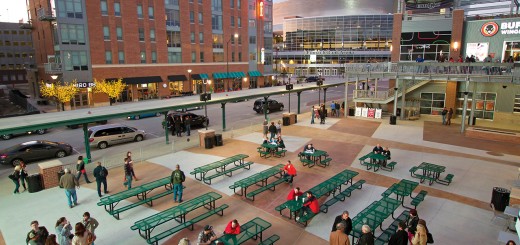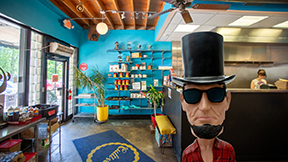A Capitol Menagerie

by Ed Zimmer
The Nebraska State Capitol is a National Historic Landmark on the short list of America’s premier historic and architectural treasures. Our Capitol is also invaluable locally, marking this place, which we call home, and guiding visitors to and around our city.
The State of Nebraska employs expert guides for Capitol visitors, available hourly when the building is open, starting in the North Lobby atop the grand stairs. But sometimes, exploring a museum or a great building on your own can reveal surprising details that you might miss on more formal tours. One clever mom who savors European paintings extends her museum touring time with her young, dog-loving daughter by tasking the sharp-eyed girl with spotting and counting dogs in the Old Master paintings.
This self-guided tour of the Nebraska State Capitol is not that creative, but you may be surprised how many animals are incorporated into the floors, walls, and ceilings of Nebraska’s greatest work of architecture. We will start with a few exterior highlights and then step inside.
Daniel Chester French’s nuanced bronze portrait of Abraham Lincoln (1912) predates the current Capitol building (constructed between 1922 and 1932) on the west side of the Capitol grounds. The nine-foot statue is backed by a taller granite tablet inscribed with the Gettysburg Address. Two stern granite eagles are at the base of the tablet on either side. Above them at the top of the Capitol tower, an eight-sided drum forms the base of the gold-tiled dome. On each side of that drum are mosaics of “thunderbirds,” drawn from Native American folklore. The Capitol mosaics may not cast lightning bolts from their eyes or loose peals of thunder from their wings. Still, their companion atop the dome — the 15-foot-tall bronze Sower — does serve as the Capitol’s lightning rod.
At the north entrance to the Capitol, bison are carved in elegant shallow bas-relief on both the fronts and backs of the cheek blocks that flank the wide front steps. On the west side of the stairs is a mother bison with a calf sheltered behind her. On the east side is a great bull.
Their rich pelts are expressed in waves of Art Deco-style curls. Above the bison are inscribed the names of ten tribes of original residents of Nebraska, for whom the great herds of bison were a major food source. Above the north entrance is another bas-relief of pioneer immigrants to Nebraska, with their covered wagon drawn by oxen and guided by a dog, a man on horseback, and an eagle. Lee Lawrie was the chief sculptor for the Capitol, designing the limestone carvings and the bronze Sower.
Within the north entrance, one glance is enough to establish that mosaics, executed by artist Hildreth Meiere, are the dominant art form enriching the walls, ceilings, and even the floors. A rich array of Meiere’s animals throughout the main floor provides symbolic content and decoration. At each corner of the vestibule is a pink marble column topped with a carved stone capital. The capitals resemble the Classical orders but feature Nebraska crops instead of traditional foliage. Oxen project from the capitol corners in place of the scrolled volutes seen in Ionic or Corinthian capitols.
Arches spring from the columns, framing a domed ceiling teeming with animal life. The arches are embellished with alternating circles and leafy ornaments; within each circle is an animal native to Nebraska. Birds occupy the center circle of each arch, including a mallard duck, an owl, and a bald eagle. The mammals range from a rat to a bison and a squirrel to a stag. In addition to the wildlife on the arches, domesticated farm animals — pigs, sheep, and oxen — appear in three of the eight larger panels surrounding the central sun.
Before proceeding down the tall hallway to the central Rotunda’s main event, pause to peek into either of the narrow stone staircases east or west of the lobby on the south wall. Each features a beautiful bronze ram’s head capping the end of its handrail.
Human figures dominate the long hallway. High on the walls adjacent to the arched windows, figures represent various professions and pursuits, identifiable largely by their colorful garments (such as a professor’s gown) or props (a basketball player’s uniform and ball). The black and white mosaics on the floor are titled as representing symbolic Genius or Spirit figures such as Soil, Plants, and Animals. That third circular design, nearest to the Rotunda, includes a goat, a mountain lion, and a chimpanzee — one of the few species in the building’s ornament not typically found in Nebraska. Even insects have a place in Meiere’s mosaics. Beyond the Spirit of Animals, a final rectangular panel puts an eagle’s wings on a male figure, who calls forth butterflies with his right hand while sowing pinecones with his left.
The floor of the central Rotunda gives Meiere’s animal mosaics their most significant role, framing and uniting the large central circular mosaic and the four smaller circles surrounding it. The artist used a guilloche — an intertwined continuous band—illustrating a chronology of life’s evolution in Nebraska. Informed by sketches from Professor Barbour of the Nebraska State Museum (now better known as Morrill Hall), Meier accurately depicted eons of Nebraska creatures in her mosaics. There are marine creatures of the Paleozoic era, reptiles of the Mesozoic era, and the flying reptiles and early birds of the Tertiary period. Her Nebraska megafauna include a saber-tooth tiger, a mammoth, and a mastodon. Yes, Nebraska was once home to cousins of elephants. A dragonfly, a butterfly, an owl and a bat round out a roster of more modern winged creatures.
A pair of colorfully painted, carved wooden doors lead from the Rotunda to the Warner Chamber, originally the Senate Chamber, before the adoption of Nebraska’s unique Unicameral one-house state legislature. Keats Lorenz carved the doors from designs by Lee Lawrie, informed by Professor Hartley Burr Alexander’s research on Native American symbolism. In addition to another fine thunderbird, the mahogany doors feature a turtle at the feet of the maternal figure and an otter beneath the man. If your tour includes access to the handsome chamber itself, the ceiling offers additional, detailed Meiere mosaics with Native American themes, and even more Nebraska animal depictions.
Finally, before departing the Capitol (perhaps to visit Morrill Hall or the Lincoln Children’s Zoo), consider a quick visit to the Law Library on the third floor. Elizabeth Dolan’s large mural on the north wall above the main entrance, Spirit of the Prairie, portrays a mother with two children and their faithful collie. This is the painting on the cover of this magazine.














Recent Comments